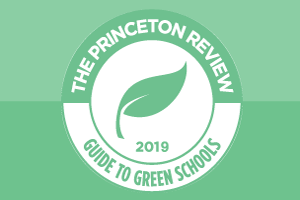Clarkson University is one of the nation’s most environmentally responsible colleges, according to The Princeton Review®.

The education services company features Clarkson University in its just-published free resource, The Princeton Review’s Guide to Green Colleges: 2019 Edition. Released on October 22, the guide can be accessed at www.princetonreview.com/green-guide.
The Princeton Review chose the 413 schools it profiles in the guide based on a survey the company conducted in 2018–19 of administrators at hundreds of four-year colleges about their institutions’ commitments to the environment and sustainability. (Notes follow on the selection process.)
Professor Susan Powers, Director of Clarkson’s Institute for a Sustainable Environment and Associate Director of Sustainability says, “This recognition is among many that Clarkson has received for its inclusion of sustainability in classes and research across campus. Our students explore sustainability topics ranging from clean energy and water to gender equity. Educating tomorrow’s leaders is the most impactful way we can assure a sustainable future.”
“We salute—and strongly recommend—Clarkson to the many environmentally-minded students who want to study and live at a green college,” said Rob Franek, The Princeton Review’s Editor-in-Chief.
Franek noted that college applicants and their parents are increasingly concerned about the environment and sustainability issues. Among the 11,900 teens and parents The Princeton Review surveyed earlier this year for its 2019 College Hopes & Worries Survey, 64% said that having information about a college’s commitment to the environment would influence their decision to apply to or attend the school.” The full survey report is downloadable at www.princetonreview.com/college-hopes-worries.
The profiles in The Princeton Review’s Guide to Green Colleges provide information about admission requirements, cost and financial aid, and student body demographics. They also include “Green Facts” about the schools, with details on such matters as the availability of transportation alternatives at the schools and the percentage of the school food budgets spent on local/organic food.
In the “Campus Life” section of its profile on Clarkson, The Princeton Review cites the campus “Take It or Leave It” event at the end of the school year to reduce the stream of trash during move-out weekend, and to give students an opportunity to acquire free, used goods as one of the many sustainability efforts the university does. The Clarkson Institute for a Sustainable Environment sponsors workshops, seminars, and a Sustainability Fund program, as well as undergraduate and graduate-level research experiences on a variety of projects around clean energy, clean water, ecology, and air quality. Students are involved in a range of projects that provide hands-on experience as they make campus more sustainable. The school is also AASHE STARS rated GOLD.
The Princeton Review first published its annual guide to green colleges in 2010. The company is also known for its dozens of categories of college rankings in its annual books, The Best 385 Colleges and Best Value Colleges.
How Schools Were Chosen for the Guide
The Princeton Review chose the schools based on Green Rating scores the company tallied (on a scale of 60 to 99) for 689 colleges in summer 2019 using data from its 2018–19 survey of administrators at the colleges. The survey asked administrators to report on their schools’ sustainability-related policies, practices, and programs. More than 25 data points were analyzed for the Green Rating score. Colleges with Green Rating scores of 80 or higher made it into this guide. The Green Rating scores appear in the profiles of the schools on www.princetonreview.com and in the 2020 editions of The Princeton Review books, The Complete Book of Colleges and The Best 385 Colleges (published in summer 2019).More information about The Princeton Review’s Green Rating methodology and its Green Honor Roll (a list of schools that received the highest possible rating score, 99) is at www.princetonreview.com/green-guide.
How the Guide’s Top 50 Green Colleges Ranking List Was Tallied
The Princeton Review tallied this ranking list based on data from its institutional survey of administrators at the colleges for its Green Rating and its surveys of students attending the colleges. Ten data points from the institutional survey were factored into the assessment. Data from the student survey included student ratings of three factors: the influence of sustainability issues on their education and life on campus; administration and student support for environmental awareness and conservation efforts; and the visibility and impact of student environmental groups.
About The Princeton Review
The Princeton Review is a leading tutoring, test prep, and college admission services company. Every year, it helps millions of college- and graduate school–bound students achieve their education and career goals through online and in-person courses delivered by a network of more than 4,000 teachers and tutors, online resources, and its more than 150 print and digital books published by Penguin Random House. Its Tutor.com brand is the largest online tutoring service in the U.S. It comprises a community of thousands of tutors who have delivered more than 17.5 million one-to-one tutoring sessions. The Princeton Review is headquartered in New York, NY. The Princeton Review is not affiliated with Princeton University. For more information, visit PrincetonReview.com. Follow the company on Twitter @ThePrincetonRev and Instagram @theprincetonreview.
Click here for a shareable link: https://www.clarkson.edu/news/clarkson-university-featured-princeton-reviews-guide-green-colleges-2019-edition